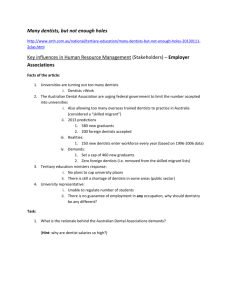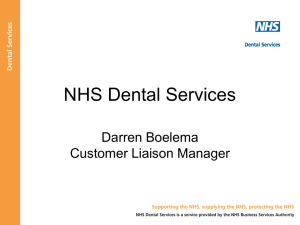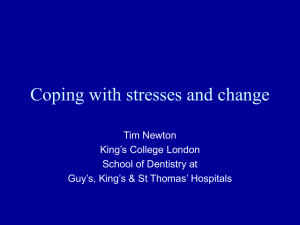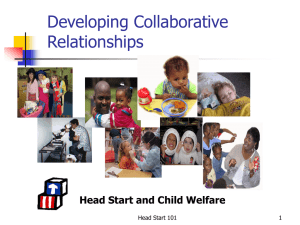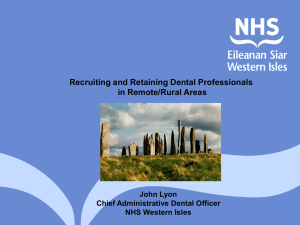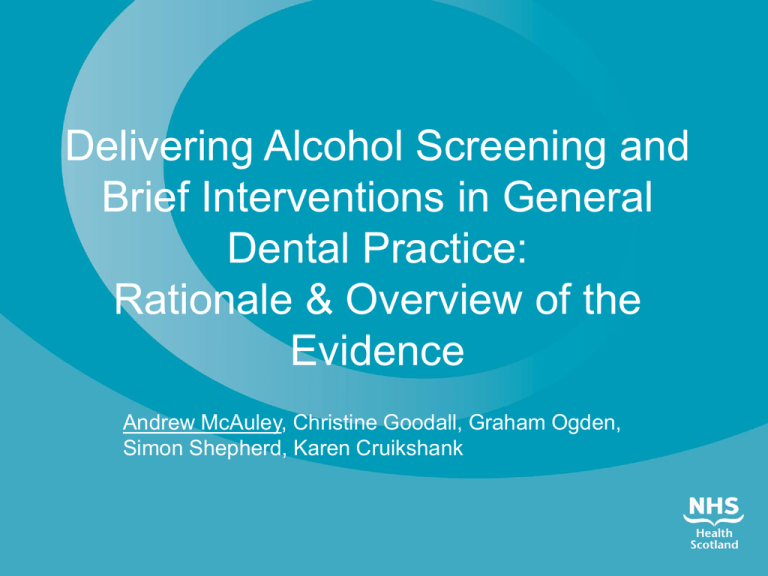
Delivering Alcohol Screening and
Brief Interventions in General
Dental Practice:
Rationale & Overview of the
Evidence
Andrew McAuley, Christine Goodall, Graham Ogden,
Simon Shepherd, Karen Cruikshank
Background
SIGN74. The management of harmful drinking and
alcohol dependence in primary care (2003)
“…all healthcare professionals have a role to play
in identifying harmful and hazardous drinkers…”
So what role for the dentist?
Alcohol and Oral Cancer
Alcohol consumption (alongside
smoking) increases the risk of
developing oral cancer and periodontal
disease (Hashibe et al, 2007; Amaral
et al, 2008 & 2009)
The incidence of oral cancer in the UK
is increasing
Increases significant across
younger age-groups and in both
sexes (Conway et al, 2006)
Strongly related to social and
economic deprivation (Conway et
al, 2008)
Linked to the parallel increases in
alcohol consumption over the last 50
years
risk for those drinking 20 units per
week (Llewelyn & Mitchell, 1994)
Oral Cancer: Incidence
Age standardised (European) incidence rates, by sex, oral
cancer, Great Britain, 1975-2007
Rate per 100,000 population
12
males
females
persons
10
8
6
4
2
Year of diagnosis
Source: cancer research UK
2007
2005
2003
2001
1999
1997
1995
1993
1991
1989
1987
1985
1983
1981
1979
1977
1975
0
Alcohol and Oral Health
There are many other clinical
reasons that dentists should ask
about alcohol:
o Non-carious tooth surface
loss
o Medical problems such as
bleeding which may affect
treatment
o Drug interactions
Oral disease can also be a sign of poorer general health and well-being.
Alcohol, violence and facial injury
In the West of Scotland…
o 73% of facial injuries
due to interpersonal
violence
o 82% drinking at the
time of injury
(Goodall et al, 2008)
Policy Context
DoH. Modernising NHS Dentistry –
Implementing the NHS Plan (2000)
Scottish Executive. Plan for Action on Alcohol
Problems (2002)
HEAT: H4 Alcohol Brief Interventions (2008)
British Dental Association Oral Health
Inequalities Policy (2009)
The forgotten tribe?
Routine alcohol screening and intervention in GDP is relatively
uncommon (Macpherson et al, 2003; Cruz et al, 2005; Miller et al, 2006; Dyer &
Robinson, 2006; Shepherd et al, 2011)
We assume doctors, nurses, pharmacists etc will tackle public
health issues associated with alcohol and drugs
Dentists often get overlooked
We don’t expect dentists to do this - or do we?
o Patients expect dentists to ask them about alcohol and are
receptive to advice (Miller et al, 2006; Goodall, 2006 & 2007; Shepherd et al, 2009)
o Dentists view provision of alcohol advice as relevant to their
practice support of relevance (Dyer & Robinson, 2006)
Until Now?...
The case for using alcohol screening and brief
interventions in GDP…
Screening
Detection of alcohol-related problems and treatment is
facilitated by use of appropriate screening tools (Raistrick et
al, 2006)
No formally recognised screening tool specifically
designed for use within general dental practice AUDIT?...
o Using AUDIT; 31% of dental patients in Scotland
drinking at hazardous, harmful or dependent levels
(Goodall et al, 2006 & 2007)
o Using AUDIT-C; 25% of patients attending dental
practice in USA were drinking at hazardous levels
(Miller et al, 2006)
Alcohol Brief Interventions (ABIs)
A short, evidence-based, structured
conversation about alcohol consumption that
seeks in a non-confrontational way to motivate
and support an individual to think about and/or
plan changes in their drinking behaviour in order
to reduce their consumption and/or their risk of
harm.
(NHS Health Scotland, 2008)
ABIs: Evidence
Strong evidence for the effectiveness of ABIs in
those drinking at harmful / hazardous levels
(Raistrick et al, 2006; SIGN74; NICEPHG24; WHO)
Primary Care, A&E
The evidence for effectiveness in delivery of
ABIs in GDP has yet to be established but…
Identified as a potential setting where they
can be effective (Cruz et al, 2005; Goodall, 2006 & 2007; Dyer et al,
2006; Shepherd et al, 2009; NICEPHG24, 2010)
ABI in GDP: Plausible Theory?
Potential to improve oral and general health
Equitable
Sustainable
Potential to reduce health inequalities:
65% of adults in Scotland are currently
registered with a dentist (ISD, 2010)
80% of adults have had access to NHS
general dental services over a six-year period
(Tilley & Chalkley, 2005)
GDP Health Improvement
Increasing role and willingness to develop skills
& participation further (Dyer & Robinson, 2006; McCann et al, 2000)
~ 90% of Scottish dentists having already
expanded their remit to include advice to
patients on smoking cessation (Chestnutt & Binnie, 1995)
50% seeing a specific role for dentists in
counselling patients to stop (Chestnutt & Binnie, 1995)
Patients also consider smoking cessation as
part of the GDP role (Campbell et al, 1999)
Barriers
Time
“….if I had lots of time with a patient I
think it would be a nice thing to
do…I’m much more interested in the
bigger picture of their whole health”
Funding
“ ..if I was getting paid to do it I
might do it…(alcohol screening)”
Training
“ we have never been educated
about how to help someone.. Where
do you start if you’ve actually no
experience..”
Confidence
“ there’s a fine line…between trying
to be helpful to someone and give
them advice and being patronising..”
(Goodall, 2006 & 2007)
(Warnakulasuriya & Johnson, 1990; Macpherson et al, 2003; Cruz et al, 2005;
Shepherd et al, 2009 & 2010 & 2011)
Facilitators
Patients are receptive to
alcohol advice (Miller et al, 2006;
Shepherd et al, 2009; Goodall, 2006 &
2007)
& 2007)
o Most felt it was important
for the dentist to ask about
alcohol (62.9%)
o Most thought it was
relevant to their oral health
(83.1%) and were happy to
discuss it (74.2%)
Frequency & length of dental
appts (Cruz et al, 2005)
Number of patients
Patients were not offended by
alcohol screening (Goodall, 2006
200
150
100
50
0
Yes
NSF
No
Were you offended by being
asked about your drinking?
Future?
Alcohol training for dentists?
o Embed within the undergraduate curriculum
o Provide PG education
o Train
Utilise Professionals Complimentary to Dentistry
(PCDs)?
Payment for an alcohol service in GDP?
o Oral Heath Assessment Review (OHAR)?
Conclusions
Alcohol is a key risk factor for oral cancer
Alcohol is associated with a range of other adverse oral health outcomes
GDPs are attended by the majority of the adult population over time
~ 30% of GDP Patients drinking at Harmful and Hazardous levels.
Increasing role of dentists in health improvement
Patients receptive to screening and intervention
Policy drivers in place
Oral Health Assessment Review – a window of opportunity?
Any questions?
Andrew McAuley
Public Health Adviser (Substance Misuse / Alcohol)
NHS Health Scotland
Public Health Science, EfA Team
Elphinstone House
65 West Regent Street
Glasgow, G2 2AF
Tel: 0141 354 2935 (ext: 2935)
Fax: 0141 354 2901
andrew.mcauley@nhs.net
www.healthscotland.com
McAuley, A., Goodall, CA., Ogden, GR., Shepherd, S., & Cruikshank, K. 2011. Delivering
alcohol screening and alcohol brief interventions within general dental practice:
Rationale and overview of the evidence. Br Dent J, 210: E15.

